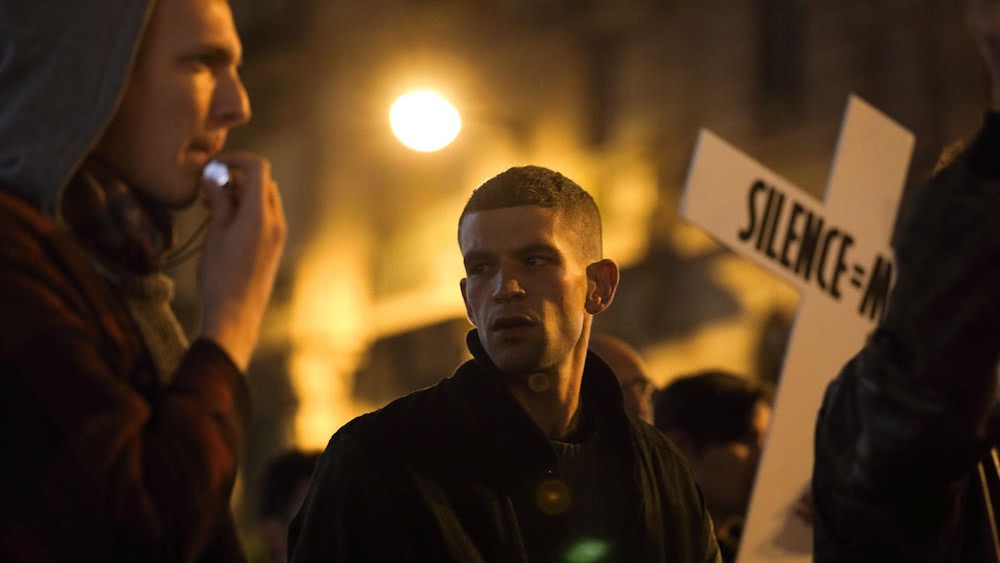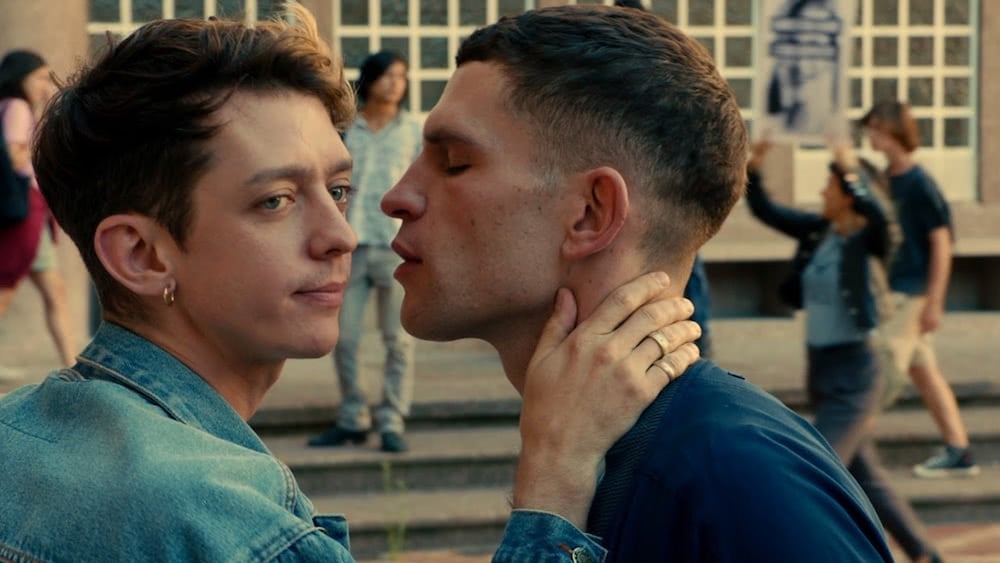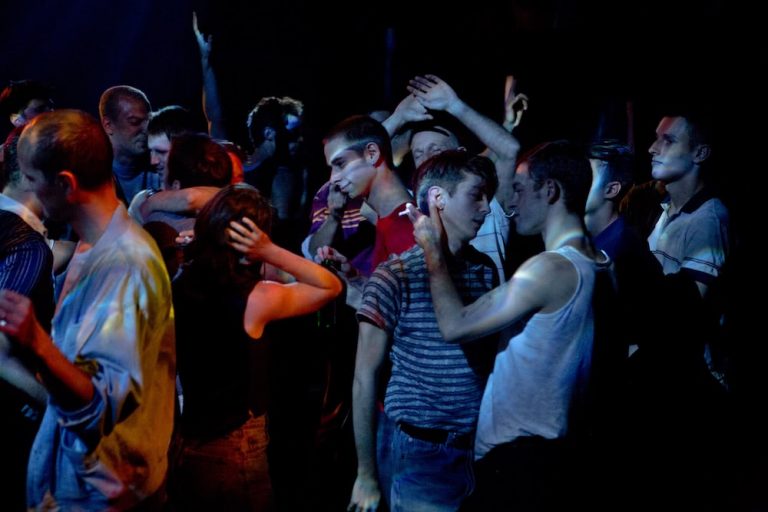Heartbeats and house beats fuse throughout Robin Campillo’s award-winning film BPM (Beats Per Minute). Set in the early 1990s, it brings us in close to the activities of the Paris branch of ACT UP (AIDs Coalition to Unleash Power), of which Campillo was a member.
BPM is a film of bodies, blood, and beats erected on a porous boundary between the personal and the political. Weekly meetings, debates, and public actions against government and pharmaceutical industry failures around HIV prevention and treatment flow into the dark womb of the dance club and the privacy of the bedroom.
All reinforce a ferocious sense of community. Arnaud Rebotini’s score connects house music to the human heartbeat. Rather than simply suggesting dancing is an escape from a difficult day, a direct line is drawn from one form of protest to another. In BPM, queer people put their bodies on the line, on the streets and in clubs.
This link is most profoundly felt in BPM’s final two minutes. Sean (Nahuel Pérez Biscayart), a founding ACT UP member and one of its fiercest activists, has died. Angry and grief-stricken, the group propels themselves into a medical insurance company dinner, throwing Sean’s ashes across buffet tables. Among them is Sean’s lover, the HIV-negative Nathan (Arnaud Valois), who we also see, in sharply intercut shots, in bed with Thibault (Antoine Reinartz), the group’s chair.
Nathan is overcome by sorrow. The music intensifies. BPM’s ‘deep house’ influenced theme incorporates a beep that mimics the sound of a heart monitor. 120 beats per minute – the measure of an elevated heartbeat, the same measure as most house music (and the film’s original title). Strobe lighting enters the demonstration and sex scenes as they morph into a new scene at a club where the activists are now dancing.
There have been other dance club scenes in BPM, but none rendered with such urgency or frantic ecstasy. Faces are dramatically ripped in and out of focus by the strobe. Bodies thrash against stasis; in every move, there is a sense of forward motion, of life pushing on, of people desperate to be seen, even as the screen turns black and silent.
Watch the trailer for BPM below
Love Music?
Get your daily dose of metal, rock, indie, pop, and everything else in between.
In BPM, as in other queer themed films like A Fantastic Woman (2017), Blue Is The Warmest Colour (2013), and Head On (1998), dancing allows the body to express many things. Dancing conveys bliss, desire, grief, and unity. Dancing brings Sean and Nathan together as they dance to Mr Fingers’ ‘What About This Love?’ Dancing is a social activity and a solo one; people are effectively alone together in the dark.
But Campillo positions his dance scenes after a protest action, allowing the elation and sense of togetherness his characters feel as they fight for their lives to explode on the dance floor. Individual identities might be subsumed in the darkness, but a collective spirit is lit. Dancing in BPM is always simultaneously political and pleasurable; always both an act of resistance and of release.
Dancing is also a reminder that the body exists in the world. BPM’s first dance scene follows a protest action at Melton Pharm. Like the protest, the dance club throbs with life. The camera stays close, absorbed with the faces of the activists, concentrated on how they experience the moment. Everyone is happy to be together and to be alive. Sean, Thibault, Sophie (Adèle Haenel), Jérémie (Ariel Borenstein), and the others are living with a disease that is still, at the time, a death sentence.
Dancing intensifies sensation, allowing them to be simultaneously in and out of their bodies, when illness constantly reminds them that their body is in decline. But while movement grounds them in the very real physical experience of their bodies, it also allows them to transcend it. Dancing takes on a spiritual, ritualistic quality, temporarily taking them out of this world and into another one.

The American iteration of Queer As Folk also imagined the gay dance club as a site for transcendence. Queer As Folk begins and ends at Babylon, the fictional Pittsburgh dance club that features prominently across the show’s five seasons. Gay men dance to the “thumpa thumpa” – the literal beat of the music but also, as one character describes it, “the gay pulse that keeps on beating no matter what.”
Babylon is a space that slows and even freezes time. Inside, under the nightly lightshow, gay men never grow old and everything is always beautiful. While Queer As Folk’s detractors were quick to suggest it promoted a negative view of gay men obsessed with youth and beauty, the significance of Babylon to the show’s political project was actually far deeper.
Watch a clip from Queer As Folk below
In season two, Michael (Hal Sparks) dates Ben Bruckner (Robert Gant), a HIV-positive man and professor of gay studies. Early in their serodiscordant relationship, Ben says that he wants to go out “to experience the now.” The scene cuts to Babylon, which surprises Michael, who assumes his Buddhist boyfriend meant something more spiritual. But Ben explains that dance is an act of worship that celebrates life. “This tribe I visited in New Guinea would dance until they collapsed. It’s how they freed themselves – from their bodies, from time.”
In the world outside the dance club, queer people have to contend with disease, discrimination, and violence. But Babylon provides a space to live in the “now” even in the face of adversity; for queer bodies to assemble together on mass, to move as one, unified in resistance to everything that seeks to destroy them.
Dancing in a gay club is then undeniably a political, even revolutionary activity. BPM’s dance scenes, when measured beside the rest of Campillo’s film, may seem small: there are four of them, five if you count a scene where Sean and Nathan stand silently together at the bar. But their significance is anything but minor when considered in relation to the history of dance music, and its particular connection to queer history, where the dance floor is a radical space.
The history of gay clubs and dance music is, like that of AIDS in the queer community, a cultural and political story told through the body. Queer New Yorkers put their bodies on the line during the Stonewall riots on June 28, 1969, to protest police infringements on what they could and couldn’t do with their bodies.
Until the 1970s, bars were the only public place in which queer people could meet each other. Greenwich Village’s Stonewall Inn was a bar, but it was also, specifically, the only gay bar in New York City that allowed dancing – a place where queer people came to interact physically in ways other public spaces didn’t allow them to. Slow dancing with a person of the same sex at this time must have felt like an incendiary act.
House music was born in the early 1980s, rising from the ashes of disco, which had emerged in the early 1970s from the gay community, at private after-hours dance parties and gay bathhouses in New York. In its earliest incarnations, house extended disco’s original profile – it was music made by and for queer people of colour to dance to collectively.
DJ Frankie Knuckles (often called ‘The Godfather of House’) and his best friend Larry Levan emerged from this scene. Knuckles moved to Chicago, taking up residency as DJ at the Warehouse. Levan remained in New York at Paradise Garage. Knuckles mixed disco with funk and hip-hop, Levan, with gospel and soul, but both created music that asserted the right of marginalised bodies to assemble as a community. House music became associated with defiance and celebration, transforming dancing into a joyous protest in praise of equality and diversity. As the scene developed, its lyrics advocated freedom, feeling good, and survival.
But dance clubs are about more than the music they play. They are also essential to the social life of the queer community. Dance clubs are a space for queer people to be together with other people like them. They enable bodily freedom for queer men and women – to dance, to talk, to hook up, and even to fuck. Dance clubs provide opportunities for pleasure and intimacy. They are a space that affirms queer identity, where people can dress how they like, say what they like, and do what they like, without fear or judgment.

Ideally then, gay dance clubs are also safe spaces. Because they are mostly queer only spaces, they offer a refuge from the outside straight world that might not understand, want to see, or even wishes to do queer people harm. The June 12, 2016 shooting at Orlando’s Pulse Nightclub was a direct attack on all of this. When Omar Mateen killed 49 people and wounded 53 others on the club’s weekly Latin Night, he didn’t just shoot at queer Latinos, but also at the sanctity of a safe, communal space.
As Justin Torres wrote for The Washington Post the day after the Pulse attack, the club was a sanctuary from the outside world, “a world that politicizes every aspect of your identity” where “they call you an abomination.” For its patrons, Pulse promised the possibility of transformation; a space for queer people to see themselves “reflected in the beauty of others.” This promise was violated. As Torres lamented, “You didn’t come here to be a martyr, you came to live.” The club’s meaning had changed.
On Queer As Folk, Babylon begins as a pleasure palace but by the middle of season three the dance club’s meaning shifts and darkens, emerging as a contested space where the personal and political collide like never before. A mayoral candidate, Chief of Police Stockwell, makes it his mission to clean up Liberty Avenue, the queer hub around which the series centres. As part of this “family values” program, the backroom at Babylon – where men have sex with other men – is temporarily closed.
For defiantly queer Brian Kinney (Gale Harold), whose agency is taking care of Stockwell’s campaign advertising, this attack on his sexual freedom in the space he most frequently exercises it, impels him to fight back. Babylon isn’t just a place where Brian goes to dance and fuck. The club’s existence is tied to his radical view of his sexuality as an identity in complete opposition to and defiance of heterosexual norms.
In one of Queer As Folk’s most thrilling moments, Brian forcibly reopens the backroom at Babylon with a sledgehammer. That he does this to the thumping beats of ’Battleflag’ by Lo Fidelity All Stars makes it all the more rousing. “Got a revolution behind my eyes, we got to get up and organise.” The song is a call to arms that Brian answers as he spends the rest of season three working to bring Stockwell’s campaign undone.
Babylon’s meaning changes once more in Queer as Folk’s final season, after a hate crime fuelled bomb decimates the club during a fundraiser staged to stop a homophobic legislative bill. Bodies have been murdered here; Babylon is no longer a playground. By this time, Brian owns the club. “Now, it’s a battleground,” he says, when explaining why he won’t rebuild or reopen it.
But Babylon has always been on the frontline of queer resistance; a place where characters have argued, protested, and discovered themselves. As Michael tells Brian in the series finale, “It’s who we are. It’s what made us.” When Babylon magically returns to its former glory and Brian dances on in the series’ final scene, it’s clear that the joyous moments are as vital as the battles.
In the end, the dance floor contains multitudes. In BPM, during the first dance scene after the Melton Pharm action, everyone is happy and unified, but something darker looms too. A visual reminder of the group’s mortality lurks in the air, in the space between their bodies. The camera rises up from the dancers, the light catching dust particles that float then congeal into blood cells. The dance club scene bleeds into a weekly meeting where the group hears about new therapies. Life and death are entangled. There is no in between. As Sean tells Nathan, “we’re either alive or dead.”
Dance music grew from a subculture whose members were decimated by a ”big disease with a little name” (as Prince sang on 1987’s ’Sign ‘O’ the Times’). Classic house mutated into techno and acid house in the UK and Europe by the tail end of the 1980s. What was once a scene for the marginalised became straighter and whiter, until its queer DNA was almost completely destroyed. BPM’s dance club scenes are also a protest against and a memorial for the loss of these bodies and this world, and for those, like Campillo, who survived. Queer bodies keep moving. The beat goes on.


































